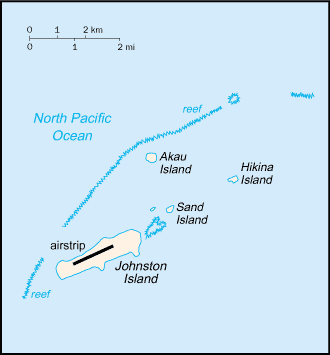
|
Johnston Atoll
Background:
Both the US and the Kingdom of Hawaii annexed Johnston Atoll in 1858, but it
was the US that mined the guano deposits until the late 1880s. The US Navy took
over the atoll in 1934, and subsequently the US Air Force assumed control in
1948. The site was used for high-altitude nuclear tests in the 1950s and 1960s,
and until late in 2000 the atoll was maintained as a storage and disposal site
for chemical weapons. Munitions destruction is now complete. Cleanup and
closure of the facility is progressing, with completion anticipated in 2004.
Location:
Location: Oceania, atoll in the North Pacific Ocean 717 NM (1328 km) southwest
of Honolulu, Hawaii, about one-third of the way from Hawaii to the Marshall
Islands.
Area: Total: 2.8 sq km.
Area - comparative: About 4.7 times the size of The Mall in Washington, DC.
Coastline: 34 km.
Maritime claims: Exclusive economic zone: 200 NM, territorial sea: 12 NM.
Climate and Terrain:
Climate: Tropical, but generally dry; consistent northeast trade winds with
little seasonal temperature variation.
Terrain: Mostly flat.
Elevation extremes: Lowest point: Pacific Ocean 0 m, highest point: Summit
Peak 5 m.
Natural resources: Guano deposits worked until depletion about 1890,
terrestrial and aquatic wildlife.
Land use: Arable land: 0%.
Environment - current issues: No natural fresh water resources.
Geography - note: Strategic location in the North Pacific Ocean; Johnston
Island and Sand Island are natural islands, which have been expanded by coral
dredging; North Island (Akau) and East Island (Hikina) are manmade islands
formed from coral dredging; the egg-shaped reef is 34 km in circumference;
closed to the public; a former US nuclear weapons test site; site of Johnston
Atoll Chemical Agent Disposal System (JACADS); some low-growing vegetation.
|
|
People:
Population: No indigenous inhabitants. Note: in previous years, there was an
average of 1,100 US military and civilian contractor personnel present.
Government:
Dependency status: Unincorporated territory of the US; administered from
Honolulu, HI, by Pacific Air Forces, Hickam Air Force Base, and the Fish and
Wildlife Service of the US Department of the Interior as part of the National
Wildlife Refuge system.
Economy overview:
Economy - overview: Economic activity is limited to providing services to US
military personnel and contractors located on the island. All food and
manufactured goods must be imported.
Statistics:
Radio broadcast stations: FM 7 (1 island-run morale, welfare, and recreation
station and 6 all-music digital radio stations broadcast over FM band).
Television broadcast stations: Commercial satellite television system, with 30
channels.
Ports and harbors: Johnston Island
Airports - with paved runways: 1.
Return to US Minor Outlying Islands
|
